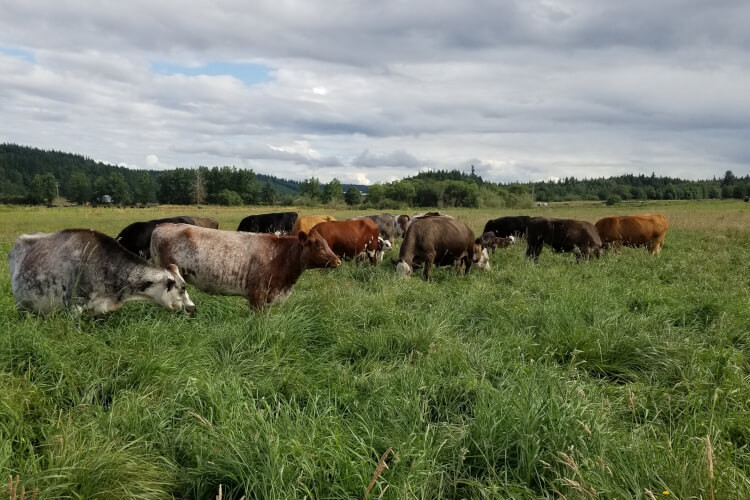Chicken Chatter – a glimpse into everyday life on the farm. [Video]
posted on
September 27, 2022
Click here to watch the video.
Many people, myself included, find chickens endlessly fascinating.
I know I am not alone because chickens are the most common theme for questions we receive about our farm!
One of my favorite pastimes is watching the chickens, and it’s an activity I love to share with people.
So this week I took my fancy video camera (read cellphone), along with a handful of wilty cucumbers and other garden trimmings, and sat myself down in the chicken pasture to record and share with you some chicken chatter.
With their incessant business, their constant chatter, their alert curiosity, it’s not necessarily a calm scene, but it is somehow calming.
The swirl of sound and activity in front of my eyes allows the swirl of sound and activity in my brain to shut off for a few minutes and I walk away refreshed.
Whether you find it calming or just entertaining, here is a short minute of footage from an everyday scene of life on the farm.
We’re not talking major action scenes here – it’s just a few minutes of chicken chatter and business – but I hope you enjoy it.
Click here to watch the video.
You can see in this video that the pastures are feeling the effects of the long summer drought. Even with the grass all dry and brown, the hens still spend their time happily patrolling for bugs and effectively fertilizing the pastures.
We’ll reap the benefits of those activities later, in the form of improved soil health and grass growth, when the rains come and the grass starts growing again!
But in the meantime, the hens are extra grateful for the greens we bring them from the garden – which makes them more cooperative subjects of photo documentary :)
The reddish hens who dominate the video are Golden Sexlinks. They are our star layers and provide the brown eggs in your carton.
The white hens, also front and center in the video, are Austra Whites and they lay white eggs.

The roosters you see patrolling the set are Cream Legbars. As you can see, roosters share in the snacking time a bit, but mostly they spend their time monitoring the situation and watching the sky to protect the flock from danger while the hens eat.
Now I have always loved watching the interactions of various roosters and hens in different flocks (someday I’ll write a story about the rooster I had named Tango), and the dynamics in this flock are particularly comic.
You may have caught a glimpse of a few gray, blue and speckled hens hanging out on the peripheries of the set. They never come close to the camera – in fact it’s almost impossible for me to get a good photo or video of them away from their shelter – and there’s a specific reason for that.
These more timid hens are the Cream Legbars and Cream Legbar crosses that I keep in my breeding flock to provide beautiful blue and green eggs.

They were hatched and raised with the roosters in this flock and learned from an early age to respect the instructions given them by the roosters.
And these particular roosters are perhaps a little over-protective of their flock. If they had their way no hen would ever leave the safety of cover, and in fact the hens that are their hatch mates stick to a fairly small foraging range because of this.
The red and white hens, on the other hand, have pretty much zero respect for male authority!
They are from a different, earlier hatch, and being raised without roosters for the early part of their life they formed their own idea of safe behavior which doesn’t jive well with the stricter (and less risky!) strictures of the roosters.
It has been fairly comic over the last few months, since we combined the flocks, to watch the roosters expend a constant flow of energy trying to make the older hens cooperate.
Whenever the roosters perceive a threat (such as me entering with a handful of garden produce), they announce a red alert and all the cooperative hens run pell-mell for cover. The other hens think the roosters are being ridiculous and run towards me, thereby necessitating the roosters to leave shelter and come out to patrol the situation – which in turn allows the hens that obeyed and fled for cover to come out and sneak treats from a distance.
It's a good thing chicken brains are small, or it would have to be a fairly frustrating situation for the roosters. After all, they’re just trying to keep everyone alive!
And the truth is, the roosters actually do protect their flock. Sometimes the “threat” is me, or a swooping flock of pigeons, but sometimes it really is an eagle! Note to all independent minded hens - disobey at your own risk.
I caught this short video of the chickens exhibiting their alert Danger Detection behavior. The potential threat turned out to be a single songbird swooping overhead so even the roosters didn’t get worked up about it, but it captures the unique Red Alert reaction.
Click here to see the Red Alert False Alarm.
All of us here at One Straw enjoy watching the chickens and we hope you do, too!

Here's Farmhand Eli resting after a long day of Kindergarten - snacking on tomatoes off the vine and watching the chickens :)




